Note from the editor
The changing cultural diversity of KMTR
Much of cultural diversity of Kalakadu Mundanthurai Tiger Reserve (KMTR) can be associated with the human enclaves within it, which is the special focus of this issue. The intricate nature of this association has been captured by an article on Vijayavel Kathirvel, a volunteer with the Agasthyamalai Community-based Conservation Centre (ACCC), who passed away recently. Born in the Kanikatti estate located inside KMTR, Vijayavel had to adapt to the changing political, economic and ecological situations that swept over the declaration and existence of the sanctuary. Just as the lease to Vijayavel’s estate expired many years ago, the lease to the Bombay Burma Trading Corporation (BBTC), which occupies about 3, 300 hectares inside KMTR, is due to expire by 2028. If left alone, the huge estate is likely to regenerate into a massive forest. However, the interview with Amrik Gill, former group manager of BBTC, covered in this issue shows how BBTC has also attempted to address conservation issues. KMTR has several other kinds of enclaves as shown by Rauf Ali’s research work. A mentor to many, Rauf Ali also unfortunately passed away recently. His contribution to Agasthyamalai and to the careers of many researchers has been captured by an article dedicated to him by Soubadra, who was Rauf Ali’s student at Pondicherry University. Rauf had written a note on the religious enclaves in KMTR such as the Sorimuthayyan temple whose impact has since increased in magnitude. The ageing managing trustee of the temple, the Raja of Singamapatty, has suggested building a wall around the temple to minimize its impact. Whether this will be built or something else done will have to be seen. Ruthamma, another employee associated with the ACCC also passed away earlier this year. Before working in the ACCC to manage the saplings in the nursery, she used to collect fuel-wood from the forests of KMTR and had to seek a different livelihood following the declaration of the sanctuary. The change in institutions and administration managing KMTR has affected not just the flora and fauna but also associated people across various classes. However, such changes are inevitable. As a stakeholder, I hope that there is constructive dialogue between stakeholders.
Allwin Jesudasan
'Mama' Vijayavel – an epitome of Knowledge on Pothigai
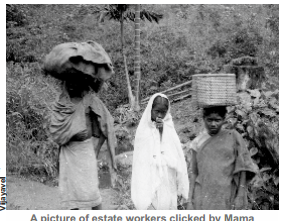
Vijayavel Kathirvel, fondly addressed as Mama by friends at the famed Pearl City Nature Society (PCNS) - and the volunteers of Tamiraparni Waterbird Count (TWC), is sadly no more among us. The word Mama, which literally means maternal uncle in Tamil, shows the love and affection people had for Vijayavel Mama. He was an active partner of TWC and a volunteer at ACCC on various occasions. He had video-graphically documented various activities of ACCC in the region which will be missed in the coming years.
Mama’s life resembles river Tamiraparani in many ways. Mama was born in the Walaiyar estate, nestled inside the evergreen forests of Agasthyamalai. Following the expiry of lease (1987) of the estate, he came down to live in Thoothukudi with his family. Quite akin to Mama’s journey, Tamiraparani originates in Agasthyamalai and joins the sea at Thoothukudi. Though Mama lived in Thoothukudi, he stayed connected with Agasthyamalai mountains by dint of newspaper articles and annual visits. He had meticulously recorded details of all his 15 visits (1977 -1st trip to 15th Trip by 1995) to Agasthiyar peak. Particulars, like routes he followed (last few trips were from the Kerala side), people who accompanied him, routes that were missed and how later traced, are all recorded in great detail. Surprisingly, during one of our field trips, we lost our way at a point close to river Peyyar, only to be confirmed by the Kani community later that Mama too once lost his way at the exact same location.
Whenever we had a chance to listen to his reminiscence about life in the forests, we wished we were botanized with him in KMTR. He must have been one among the few, who could have followed the foot-print of Col. R. H. Beddome (British Forest Officer) and his plant collectors. Mama has left a document that describes Agasthyamalai and its surroundings, especially origins of river Peyyar and river Walayar. The document also opposes the highway through Agasthyamalai into Kerala and describes the importance of river Tamiraparani and its origin (Chimunji peak and Kalivayilpil peak). Perhaps, the first after Col. R. H. Beddome, Mama used his knowledge of catchment areas of Tamiraparani to explain importance of forests for maintaining water resource. He has documented catchment area of every stream originating from various Agasthyamalai peaks. Sadly, we could never trek with him in the forest due to his arthritis and heart ailment.
Mama has also documented many Bungalows inside the forest built by British Forest Officials and trails that traverse the dense forests of Agasthyamalai. Using his careful documentation of rainfall in Walayar Forest over 45 years, he had deduced how the annual rainfall varied from 4444mm —5281mm and rainy months were distributed across June to January with total number of rainy days to be 200. He had carefully estimated the annual rainfall to be around 5585mm.
Mama also estimated that the tributaries of Tamiraparani —river Peyyar and river Walayar —originate around the Chimunji Peak. We wish he had lived for many more years, so we could have unearthed hidden treasures of knowledge about the Pothigai (Treasure trove in Tamil). As the legend goes in Tirunelveli region -Sage Agasthya is living around the Pothigai peak even today; and no doubt, Mama’s departed soul is perhaps going around Agasthyamalai, protecting the biological treasures of the mighty mountain.
Ganesan R & Saravanan A
rganesan@atree.org
saravanan.amavaasai@atree.org
Rauf Ali – the maverick primatologist of KMTR
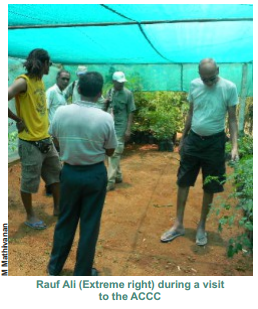
My first encounter with Rauf was a strange one —he interviewed me in 1987 for the M.S. Ecology program at Salim Ali School of Ecology, Pondicherry University. Reacting to most of my answers he would go into peals of laughter, soon followed by Devi - another professor at the university. Post interview, I walked out with a hollow feeling, but I soon came to know that I was selected for the program. Then came statement in class which claimed, ’don’t believe in text books —buckwass!’. He had brought up the culture of critical thinking, before accepting any theories and norms. Soon we were writing open book exams; unable to trace answers to his quiz in the books would send most of us on a tizzy, of course! Perhaps, we were the one and the only batch that Rauf taught formally in a classroom. Then started our field trips with him to the most exotic places. However, to say the least, we will be most grateful to him for introducing us to the forests of the Kalakadu Mundanthurai Tiger Reserve (KMTR).
Our first visit to KMTR is vivid in my memory. All of us students were tucked inside the bungalow and those spilling over, occupied the verandah. Busy days of data collection, night walks and ghost stories followed thence upon! Soon, many of us were following his study troop of macaques (rather their descendants). Sengaltheri - up in the hills - gave us the glimpse of wet evergreen forests. Many evenings were spent with him sitting lined up like his macaques on the parapet wall to watch gaurs and elephants graze on grassy hills opposite to Sengaltheri. Recently, I realized that his Facebook page carried pictures of the very same hills.
Never will I forget his statement on Kakkachi —“Where else can you get off a bus and step into a most well preserved forest?” Today, Kakkachi has become our long term monitoring site. My last exchange of an email with him was regarding the ’one-mile corridor’, which saved the connectivity between two patches of critical habitats of the lion-tailed macaque in Kakkachi. In his interview with Pankaj Seksharia, he mentioned that the conservation movement to save the ’one-mile corridor’ happened much earlier than the famed ’Silent Valley’ movement.
I have not been fortunate enough to work with Rauf, but drew all inspiration from him to fight my wars in KMTR. Rauf passed away on the 31st March. He will be truly missed.
Soubadra Devy
soubadra@gmail.com
Ruthamma, a life transformed
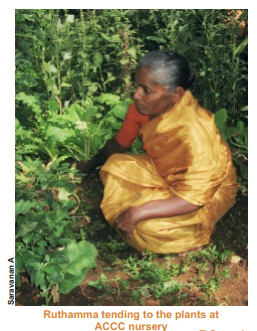
Ruthamma alias Saraswathi was in charge of the nursery, maintenance of the office and other buildings in the ACCC, in addition to her cherished care of the dogs at the field station. She passed away on 5th April 2016, leaving behind a memory of care, concern and uprightness towards ACCC and the people who come to stay there or visit the place. Saraswathi began her life as a forest fuel wood collector and she was no ordinary one. She defied anyone who stopped her from going to the forest and even threatened them with the aruval (sickle) and if that did not work, she would find other ways! With age catching up and having lost her daughter and husband, she took solace in the arms of Jesus and came to be called Ruth-amma. That was when we hired her to take care of our small nursery and field station at Singampatti in 2002. Life took a turn after that. Ruthamma was energized and had committed herself to raising seedlings and saplings of hundreds of trees, sitting all day in the shade, filling packets with manure and soil or aggressively pulling the hose to water far away plants in the hot sun. Come lunch time, she would feed the dogs and then retire into the shade with her dabba to have a peaceful meal. On Fridays, she had the additional job of bathing the dogs - some coy and some really unruly. Her day would finally come to an end with filling in her log book on work she did with the help of people at the field station.
Ruthamma was remarkably punctual and I could set my watch with her arrival. Over the years, I would wait for 9 am when she would come with a “Vanakam Sir, tea venuma?” (Hello sir, would you like some tea ?) This had become a practice and my day would only start with a tea from her. I always wanted her to accompany us into the jungle to show us how it was during her times. One day she agreed and we walked inside the forest through the thorns and rocks. She nimbly stepped aside to avoid them as she would have done years back. We reached a summit and from there we could see the ACCC. She pointed to different plants, places, nooks and corners she had gone to source fuel wood or hide from men. Even though she would have cut hundreds of trees in her youth for a living, she had raised thousands that has helped green the villages of Singampati, Papankulam and beyond. She was in the processes of putting up a nursery manual for ACCC and the best tribute to her would be to complete that.
T Ganesh
tganesh@atree.org
Tea, weeds, forests and… people?
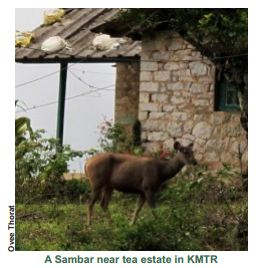
On a fine sunny February afternoon, at the far end of small Netrikal dam, was a large snake swimming in hot sun. A look through the binoculars revealed it to be a king cobra, crossing the dam waters to reach our side of the shore. I knew then we were not far from the high elevation abandoned tea estates of Netrikal and Chinna Manjolai. A short walk through the Iyethal, keeping a sharp watch for the lurking cobra, brought us to a clearing, and tucked to one corner of it was a dilapidated stone structure with nothing but the tin roof and wall standing. We would be staying in this place for the next few days in the company of snakes and birds, as we would collect information on birds and regeneration of natural forests in the abandoned tea plantation. Over the next few days, we walked through the plantation which was once a thriving place full of people and tea planters some 30 years ago. Now it’s desolate, tea has grown to a tree and planted orange trees gave plentiful supply of juicy fruits while natural forest or grass trying to come up through them. We found plenty of animal signs, including pug mark of a tiger and its prey species. Couple of days later, we went down to Chinna Manjolai about 400 m below Netrikal, on yet another hot and dry afternoon. We reached the stream nearby and the lovely little hut overlooking the eastern plains of Tirukanakudi, which was an extremely welcome sight in the hot sun. This was wildlife country; Prashanth had some funny encounters with two bears while elephants regularly blocked our way through the forest. The tea looked wilted, dry and over powered by the invasive lantana and the forest plants were desperately trying to re-establish through them. We trudged back and hit the plains after few days in the hills, to reach another estate —BBTC - which on the other hand is actively managed and not abandoned like Netrikal. The BBTC lies on a leased land that has to be returned to the government in another 11 years. There are big questions now- what will happen to the estate if left alone? will forest take over, or, will tea as a tree dominate the place as in Netrikal? Or, will lantana suffocate the place? Chetan’s work was specifically designed and studied to explain such processes and it appears that both regeneration or colonization by the invasive weed can happen depending on elevation of the location. Manjolai may suffocate under lantana, while the higher Manimuthar estates might get dominated by tea, and may be, few pioneer forest species will establish as they did when some fields were abandoned for few years. So what would be the options to stop the takeover by lantana or tea? Part of the answer lies on retaining shade trees planted in the estate which are focal perches for birds to bring in seeds of native tree species while allowing them to get established quickly in the estate. There are of course other issues of soil characteristics, aspect, or slope which can have variable effects on what finally come up in such places. While it appears that forest may take over tea, but as to how long will that take to happen, and, what should one do to enable such a process, is a matter of debate. While this is one of the scenarios, the other arises when tea continues to exist. The landscape would remain as a productive one that supports livelihood, infrastructure, fair amount of wildlife and importantly some amount of regulation. Whatever it may be, a judicious approach is needed to handle the situation, as it emerges in the coming decade.
Coffee and Spice enclaves and Forest conservancy in Tinnevelly District
Historically, it has been the stream which irrigated their paddy fields that made the people of Tinnevelly to venture into the upstream forests. Such ventures were either made to tame the streams to fill up their tanks and irrigate the fields, or, to safeguard water resources that originated from the forests. Good revenues from paddy cultivation was critical for the erstwhile regional administrators, be it either Poligars or British. Exploring the hills of Agasthyamalai forests over the years, they have consolidated the stream flow by diversions and filling up their tanks for paddy and similar wetland crops.
In addition to this, during the British management, commercial interests on plantation crops, especially spices- nutmeg, clove, cinnamon, cardamom- coffee and tea led them to explore the forests. In ’Tinnevelly’, an ’experimental spice garden’ was established at Courtallum by 1798 and by 1802 imported stock of nutmeg, cocoa and clove saplings from Amboyna, Indonesia were planted. Coffee also was part of cultivation in Courtallum hills and R. Wight, a plant collector from British era, recommended the coffee to be of good quality and recommended scaling up cultivation and crop marketing.
In the following years, there was a great rush in establishing plantations after the British consolidation of Madura and Tinnevelly(ca.1802).By 1850, the rush to establish plantations, attained its peak, especially in the Nanguneri forests (Tirukurangudi and Kalakad ranges) and Tenkasi taluks (Couratallum Division). Forests in the shelters on the eastern slopes from which streams and rivulets descended have been targeted for raising coffee, cardamom, nutmeg, clove etc.In the process, forests have been cleared to the extent that gusty westerly winds and heavy monsoonal rains had their rampage on leftover green cover. Coffee plantations did not do well and most of them have been abandoned. Around 1876, there were around ten estates that cultivated coffee in addition to other crops such as clove, cardamom, nutmeg etc. and the acreage ranged between 50-300 acres. Over time, farmers in the plains felt that their water resources were drying and their crops failed due to the heavy usage of water in the plantations on the mountains.
Interestingly, plantations had one major cascading outcome —that is, the conflict with the revenue generated from the wetland cultivation. For district collector R. K. Puckle, major concern was generating revenue from the rice bowl of southern Madras Presidency. He was the celebrity collector among farmers for revamping irrigation system in Tamiraparani river basin. He blamed the forest clearings high in the mountains for the streams drying up during normal rainfall years, and, floods during high rainfall years. Puckle stopped issuing license to cut timber and charcoal burning, restricted fuelwood cutting, stopped grazing cattle in the forest but did not interfere with the plantation crops. He recommended the formation of a ’Special Department’ to manage the forests, as no Department for forest management existed then. Thus coffee and spice plantations were the reasons in Tinnevelly district that is marked as the first milestone in the history of forest management in Madras Presidency. This was a result of taking the lead from the Forest Conservancy rule developed by Cleghorn in 1856. As a follow-up of Forest Conservancy act, by 1964, Col Beddome visited Tinnevelly district to advise on the conservation of forests, but five years later, following his second visit, he accepted the fact that the efforts had failed in conserving the forests. His concern on the dwindling forest revenue was in contrasts to that of Puckle’s interests and intentions.
The State Forest Department, at present, is striving to protect the forest through branding the charismatic mammal Tiger. Approaches of forest conservation may be different now, but the ultimate benefit is in the form of water that takes care of the exploding population of the same Tinnevelly district and also regions that do not belong to the Tamiraparani river basin. Expectations of people seeking ’water’ from the forest has not changed and the responsibility of people towards forest —’conservation’ also has not changed even after 160 years and this relationship might seemingly persist forever.
Sources: A Manual of the Tinnevelly District in the Presidency of Madras, A. J. Stuart, 1879. Madras.
Madras District Gazetteers – Tinnevelly – Vol. 1, H. R. Pate, 1917. Madras.
Spice Gardens of Tinnevelly http://www.bl.uk/manuscripts/FullDisplay.aspx?index=0&ref=IOR/F/4/1187/30806
The State Forest Department, at present, is striving to protect the forest through branding the charismatic mammal Tiger. Approaches of forest conservation may be different now, but the ultimate benefit is in the form of water that takes care of the exploding population of the same Tinnevelly district and also regions that do not belong to the Tamiraparani river basin. Expectations of people seeking ’water’ from the forest has not changed and the responsibility of people towards forest —’conservation’ also has not changed even after 160 years and this relationship might seemingly persist forever.
R Ganesan
rganesan@atree.org
Interview with Amrik Gill, Former Group Manager , BBTC
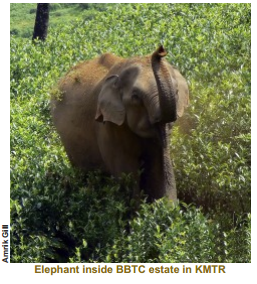
I) Can you describe the most memorable encounter with wildlife as Group Manager of Bombay Burmah Trading Corporation(BBTC)?
I have had several memorable encounters with wildlife in the BBTC estates. A late morning visit by a panther to our bedroom; seeing a pack of 28 wild dogs hunting down a sambar; a python devouring an over 50lb langur resulting in the death of both the python and langur - are some memorable encounters.
II) Do you think the BBTC has contributed to wildlife conservation in KMTR?
Hugely! Conscious positive management outlook favoring Wildlife conservation instilled needed discipline and confidence among corporation employees. The philosophy was that of the company business surviving, while also living harmoniously with Wildlife. This visualization has cut through the mental chatter transforming the managers’ minds for conservation. It dawned on managers that the company, by conserving wildlife, could create a life of enjoyment, while still running plantations successfully. Managers started envisioning that they could program their minds to affect intended outcomes.
BBTC has taken several steps keeping wildlife in mind. For example, BBTC is the first in plantation industry to adopt organic cultivation practices, ensuring pollution-free water sources for Wildlife. We installed wind mill turbines for power, solar air preheating system for drying tea, cutting down CO2 emissions. We left wide forest corridors for facilitating area to area Wildlife movement. BBTC volunteered logistical support to Steve Green, Karen and John Oates (all three are primatologists) for studying the lion-tailed macaque’s social behavior. These steps are not isolated individual actions, rather, a conscious policy direction from top corporation management.
iii) What do you think are the advantages of extending BBTC’s lease to continue the estate in KMTR?
BBTC presence in the area is a sobering influence on forest officials. Conscious wildlife conservation policy imparts needed discipline among corporation employees. Presence of BBTC is a hedge against otherwise a threat from locals to Wildlife. BBTC no longer stands as an overwhelmed spectator to wildlife destruction, and rather is a conservation participant. It will be a regressive step to discontinue BBTC as far as wildlife conservation is concerned.
Naraikadu and its Management
Amy Carmichael (1867 —1951) was born in Ireland and served in India for 56 years until her death. In 1901, she began to make a Home for children in need of protection and care, and ’The Dohnavur Fellowship’ was born. The Fellowship had become a sanctuary for thousands of children who would otherwise have faced a bleak future.
Amma, as Amy is fondly referred to by all her children, was keen observer of Nature and wrote hundreds of poems inspired by the grandeur of nature. In 1917 she bought a piece of land in the mountains near Dohnavur. Naraikkadu, as it is called, is nestled in a deep valley between gigantic peaks, and a perennial stream flows through the dense tropical forest. Amma desired that all her children develop an appreciation for the natural wonders around them from an early age, and thus took them to Naraikkadu for spiritual rejuvenation. She likened the forest to a great Cathedral in one of her poems and insisted that the place must be kept as pure as possible like a place of worship.
Lord, here Thy great Cathedral stands
A house of God not made with hands
High overhead the splendid roof
From trivial thoughts how far aloof
Thy hand piled up these mighty walls
Made for sweet music streams and falls
Filled it with Bird song, dressed with flowers
And ferns and moss, and made it ours.
- Amy Carmichael,
Amma, the ardent naturalist was far ahead of her times in spreading the message of conservation of natural resources. The once coffee plantation is now a living testimony to her efforts in preserving the Forest from denudation. Mr. Godfrey Webb —Peploe (1901 —1949) who served in the Fellowship, was the first and foremost explorer and naturalist, who roamed these mountains and documented precious information on the flora and fauna of this region. He was a keen amateur meteorologist and established the documentation of weather data which is continuing till today. Log books are maintained separately for all the houses, which serves as a rich treasure trove of information for all the generations to come. In the first Log Book (1917),Amma had written ’There is enough place for everyone in the forest including us, Harm nothing’. She was totally against the anthropocentric view of dominating the nature in those days of Shikar, but tried to instill the culture of respecting nature by meditating and worshipping the Almighty amongst the woods.
Strict rules are still being observed since Amma’s time relating to the harming of flora and fauna and polluting the streams. The children and staff of the Fellowship visit the valley periodically and get rejuvenated spiritually. Bird watching, trekking, meditation, poetry composition and music are some of the activities in which our people indulge with inspiration. The children are encouraged to explore scientifically and develop an aesthetic appreciation alongside developing physical toughness as one has to trek a distance of nine km in the mountains, as there are no motorable roads to reach the bungalow. The place is also devoid of electricity. No casual tourists are allowed, except researchers and nature enthusiasts, in consultation with the Forest Department. The financial worth of this mountain abode is priceless and cannot be valued in terms of money. Plantation was stopped since 1970’s and the cost of maintaining the buildings, bridges and so on, which is rather expensive, is only possible by the benevolence of charitable donors.
To sum it up, the foremost underlying principle in managing this forest is to treat it as a place of worship and view every nook and corner of the landscape as an integral part of a vast cathedral, and to seek the ultimate truth by encouraging scientific research and aesthetic appreciation.
We will be celebrating the 100th Anniversary next year, and God willing, we do hope that this valley will be an example of the sincere efforts from private players to promote conservation efforts in close harmony with the forest department over the years, to the succeeding generations.
D.R.Jeremiah Rajanesan
The Dohnavur Fellowship
vanacharbu@gmail.com
New winged visitor to ACCC campus
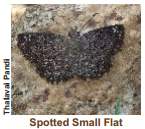
The ACCC campus is home to over 50 species of butterflies. Some species, such as the Common rose (Pachliopta aristolochiae), Blue Pansy (Junonia orithya), Large Oak Blue (Arhopalaamantes), Pioneer (Belenoisaurota), and Common Banded Awl (Hasora chromus), can be sighted frequently. On a chance encounter, I came across a Spotted Small Flat on 19th November 2014.It was 10 am and the butterfly was basking on the ground when I used the opportunity to click a good picture. While I tried to click another picture, the butterfly moved away on a fast and jerky flight. I was not able to identify the species immediately, however, when I later posted the photograph on the Tamil Nadu Butterfly Society Facebook group, the experts managing the group confirmed this species as Sarangesa purendra. I referred the field guide - book of Indian Butterflies -by Isaac Kehimkar and website of Butterflies of India (http://www.ifoundbutterflies.org/) and found out that the species is endemic to the Western Ghats, has a probable 25-35 mm wingspan with blackish brown on the upperside and semi - transparent white spot on the fore wing. It has hairy fringe with indistinctly chequered hind wing and sub marginal row of spots. I was told by butterfly experts that this particular species was recorded in the British period from Tamil Nadu. In 2014, this species was once again recorded in Grizzled squirrel wildlife sanctuary, Srivilliputhur by Kumar et.al.
Thalavai Pandi
enviropandi@gmail.com
Event Report
Scaling up from T amiraparani Waterbird Count to T amiraparani Waterbird Festival
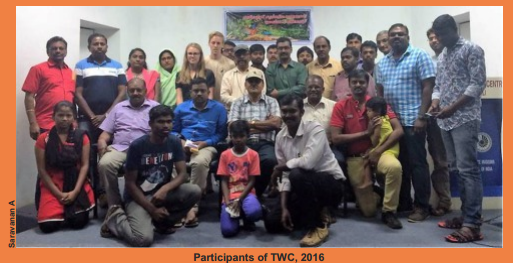
Tamiraparani Waterbird Count (TWC) was kick started by ATREE in the year of 2011 with 13 locals and 14 bird experts from southern India. Year after year, the popularity of TWC is increasing and it has now become flagship event of the landscape. The number of volunteers has increased many folds. This year, we brought in the concept of Tamiraparani Waterbird Festival (TWF), which includes additional events apart from TWC. Over 700 locals and students participated in the event. The preparation meeting of TWF happened at Susee Auto Showroom, Thoothukudi, members of Pearl City Nature Society (PCNS) and Nellai Nature Club (NNC). A press release was issued calling out for volunteers and many volunteers registered too. Orientation lecture for the volunteers was conducted at St., John’s College, Palayamkottai, followed by release of an Android application on Waterbirds of Tamiraparani by Mr. Gunasingh Chelladurai, secretary, St., John’s College, Palyamkottai.
For the census, over forty tanks were covered in two-day time. Overall, 22,676 birds belonging to 62 species were recorded, which includes 25 migratory species.This included ducks (13,017) followed by herons, cormorants etc. This year, a photo competition on Tamiraparani wetlands was organized to encourage nature photography. Nearly 60 participants sent over 150 photographs. One special prize, first three prizes and 20 consolation prizes were given away during the valedictory event.
A photo exhibition on Tamiraparani water birds was organized at District Science Centre, Tirunelveli on 29 January 2016. Nearly 100 photographs of birds, wetlands and activities of bird census were displayed along with notes on Tamiraparani and map of Tamiraparni wetlands. Mr. Shenbagamoorthy, I.F.S., Conservator of Forests, Tirunelveli, inaugurated the exhibition. Over 25,000 visitors swung by and over 600 students from various schools from the district participated in art competition on birds.
We acknowledge PCNS, NNC, District Science Centre, St., John’s College, Palayamkottai, Tamil Nadu Forest Department, Public Works Department, Nellai Press Club, Photo Park, Tirunelveli.
TN Special Police joins hands with Green Ambassadors of Vagaikulam
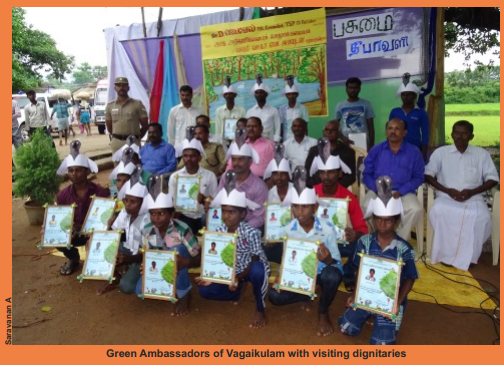
Vagaikulam is one of the major breeding center in Nanalkulam, Tirunelveli district next to Koonthankulam bird’s sanctuary. Nearly 15 bird species breed here and over 25 species roost from October to April. Babul trees were planted at Vagaikulam in the year of 1996 under SIDA programme by Social Forestry division of Tamil Nadu Forest Department. These trees were auctioned for felling in 2007. Almost 70% of the trees have been cut. ATREE researchers discovered Vagaikulam heronry in 2008 and ATREE has been conducting many awareness programmes in the villages situated close to the tank. One such village is Nanalkulam. The locals of Nanalkulam have been very supportive of conservation activities. In 2011, Social Forestry gave permission to cut rest of the trees, to which, the people of Nanalkulam protested and succeeded too.
Nanalkulam has also been celebrating cracker-less Deepavali to ensure that the bird habitat is not disturbed. To honor the people and kids of Nanalkulam village, ACCC organized green Deepavali celebration at Nanalkulam village. Tamil Nadu Special Police IX Battalion force came to the village to celebrate green Deepavali and encouraged the villagers. Mr.Muthuraj, a resident of Nanalkulam village narrated the programme and gave brief introduction about the village. Mr.Mathivanan of ACCC welcomed the gathering whereas Mr.Elango, Range Forest Officer greeted the villagers. Mr.D.Jayavel, Commandant, TSP IX BN, chief guest, distributed ’Green Ambassador Award’ to 18 youngsters of Nanalkulam Village, who are associated with monitoring and conservation programmes of Vagaikulam birds. He gave special talk to the people of Nanalkulam congratulating them for their service to birds. A 5-minute long documentary on Vagaikulam was screened.
Snippets
- During the night survey in the grassland patch behind the ACCC campus, Surya and Priyanka participant of Conservation Science course, sighted a rare gecko “Hemidactylus scabriceps” on 10 July 2016, rediscovered from Nagapattinam which is originally described from Ramanathapuram district.
- A rare morph of Ahaetulla nasuta (Common green vine snake) with pinkish ventral scales (usually green or yellowish green) was sighted close to the ACCC campus on 14 July 2016 by Surya Narayanan. An individual with similar ventral colour was earlier mentioned as variety Rhodogaster by F. Wall by 1900 from Upper Burma and Assam.
- Thalavai pandi and Saravanan encountered aTamil Lacewing butterfly on a drumstick tree on 14August 2016 in ACCC’s nursery. This is a new record at the ACCC.
- ACCC organized workshop on snake awareness and conflict mitigation for Tamil Nadu Special Police IX B N on 16 November 2015.
- T.Ganesh, R.Ganesan, Tamizhazhagan, Surya Narayanan, Abhishek Samrat, Saravanan sighted three elephants in Kakkachi on 6 April 2016.
- Tamizhazhagan spotted one sloth bear in Kakkachi on 25 February2016.
- Red-wattled lapwing and green bee eater nests found in ACCC campus in April 2016.
- Thamizhazhagan spotted a jungle cat on ACCC campus on 15 April 2016.
- Thamizhazhagan and Sharadha Ramadoss spotted two Indian foxes at Peykulam grassland during field work in June 2016.
- Ganesan R sighted Malabar Banded Swallowtail (Papilio liomedon) butterfly and its caterpillars at Kakachi forest on 4 May and 7 May 2016 respectively. Caterpillars were found on Acronychia pedunculata (Rutaceae) leaves which were half-eaten. It has not been sighted from the eastern slopes of southern W.Ghats.

